'A sad hand at your punctuation': if writers don't care, why should we?
When I lived in Scotland while doing my PhD, I once threw a 90s music party for which people were asked to come dressed in what that era requires: garish make-up, pigtails, baggy shirts, large loud patterns. My flatmates didn’t believe it would work and anybody would follow that dress code. They did, and it did work.
I think of myself as a 90s kid, but you don’t need to have grown up then in order to know one of the biggest party hymns of the time. I’m talking about ‘I’m blue, dabedee dabedi’. And by just so much as you reading the this, you’ll have the entire song at your disposal in the mind, you’ll be singing it internally, your musical brain inevitably drawn by the catchy refrain. An earworm you won’t get rid of for a while. You’re welcome.
I recently came across the history of the song by Eiffel 65. It’s firmly and squarely a collaborative one, facilitated by the physical environment in which the three artists who produced it met: a set of single-room studios with badly isolated walls somewhere in Italy. One day, composer Maurizio Lobina played a piano tune (that refrain that gets stuck in our heads) which was overheard by Jeffrey Jey who joined him together with producer Massimo Gabutti to play around in his studio. After a day of throwing their ideas together, they had it. ‘Blue’ was born.

It doesn’t matter that it flopped at first, and the three forgot all about it, and moved on. It matters that the phone did ring a year later or so: ‘Blue’ was played by an Italian radio station, and people loved it. It went viral before we even knew what viral meant, and the three toured the world’s stages, featuring with the likes of Destiny’s Child and Britney Spears. The newness of the song may have passed, but the tune is still so current, so catchy, that even after 20 years it still holds the dancefloor.
And all because of those thin walls.

If ‘Blue’ was born to three fathers, and we don’t mind that, don’t ask who was responsible for which part of it, why should it be any other with literary works? Why do we keep hankering after original texts, versions the way the author intended it, trying to “purge” the text from corrupting influences of copying scribes, editors, and type setters?
Why do we fetishize the idea of the lone god-like author? Why does collaboration in writing, especially of the kind that makes it hard for us to tell who did what – why does that make us nervous?
Punctuation can help us think about some of these things, and here’s how.
The example from ‘Blue’ fed back into literature opens up three avenues for exploration:
- whether we think punctuation matters
- different editing styles
- our (modern) attitudes, beliefs, and behaviours towards texts
The first issue splits into two branches, depending on whether the author cares about their punctuation.
One is easy. If an author cares, so should we. Witness Mark Twain, Laurence Stern, or Ben Jonson who supervise the printing process of their work, and who keep insisting on the printers retaining the punctuation they chose themselves. We must, therefore, take punctuation in their texts seriously, because it is one of the ways in which they communicate, and manipulate meaning. We have to familiarize ourselves with what it means to them then, and see what it can mean to us now.
The second issue is a bit trickier, because it’s intersectional, as it were.
If the author doesn’t care about their punctuation, why should we?
Well.
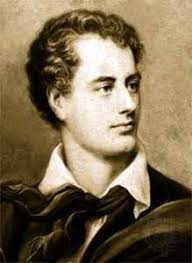
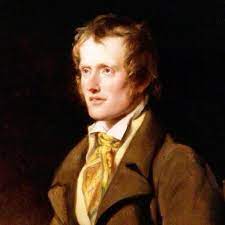
Let’s consider the author left her punctuation willingly up for someone else to re-work, an editor, say, or a friend, and there are plenty of examples of really big literature names where precisely that occurred: take Lord Byron who writes to John Murray in 1813, asking if he knew someone ‘who can stop – I mean point’, because he was ‘a sad hand at your punctuation.’ Or Wordsworth who, for the second edition of the Lyrical Ballads in 1800, asked the famous chemist Humphrey Davy for help: ‘You would greatly oblige me by looking over the enclosed poems, and correcting anything you find amiss in the punctuation, a business at which I am ashamed to say I am no adept.’ I find it interesting that the poet leaves punctuation of his own work up to a scientist, and that he is ‘ashamed’ he does not know the rules well. That means that, by 1800, there was already a perceived standard of punctuation, and that, even then, there existed a stigma around correct application of the same.
One might also argue that the fact that Wordsworth and Byron were happy to leave the punctuation of their poetry up to someone else suggests that it doesn’t much play into what and how their poetry means. We can just focus on the content, focus on the rhyme, syllable number, stress.
There can, however, be made a case for caring about an author’s original punctuation, regardless of how sloppy or careless they were concerning the dots and the dashes. Take John Clare, the nature and natural poet, whose ampersands consistently disappeared from the edited printed texts. Here’s one of his sonnets written between 1832 and 37 with original punctuation.
The shepherds almost wonder where they dwell
& the old dog for his night journey stares
The path leads somewhere but they cannot tell
& neighbour meets with neighbour unawares
The maiden passes close beside her cow
& wonders on & think her far away
The ploughman goes unseen behind his plough
& seems to loose his horses half the day
The lazy mist creeps on in journey slow
The maidens shout & wonder where they go
So dull & dark are the november days
The lazy mist high up the evening curled
& now the morn quite hides in smokey haze
The place we occupy seems all the world
Note the ampersand sign and the lack of full stop at the end. Subsequent editions replaced & with ‘and’:
The shepherds almost wonder where they dwell
And the old dog for his night journey stares
The path leads somewhere but they cannot tell
And neighbour meets with neighbour unawares
The maiden passes close beside her cow
And wonders on & think her far away
The ploughman goes unseen behind his plough
And seems to loose his horses half the day
The lazy mist creeps on in journey slow
The maidens shout & wonder where they go
So dull & dark are the november days
The lazy mist high up the evening curled
And now the morn quite hides in smokey haze
The place we occupy seems all the world.
There’s a fantastic chapter by Simon Kövesi on Clare’s ampersands and the way the curvy shape of the sign which doesn’t even require a lifting of the pen, but can just be drawn in one fluid stroke, its tail potentially morphing into the next letter following it, how the shape in itself spells connection, and a connection that’s democratic and horizontal. He says it much better than me, so here’s a quotation:
‘Clare’s predominant use of the ampersand when representing the natural is in terms of its coordinated, levelled, planar, anti-hierarchical shape. It also attests to a world which is fluid, de-centred, in flux and always in the process of becoming.’ (Simon Kövesi, ‘John Clare &…&..&…’ in Ecology and the Literature of the British Left edited by John Rignall and H. Gustav Klaus, Farnham, 2012).
There’s no difference between the milk maid and the cow, the shepherd and his dog, ploughman and oxen, neighbour and neighbour. The November fog effaces boundaries between human and animal, and indeed any creature and another, even our sense of time. Morning could as well be evening, this place every other place, ‘the place we occupy seems all the world’, dwelling without border, and without full stop as the poem’s lack of contours leaks into the white space of the page below and around it, and thence into the reality of the reader. And all because of the ampersand for which we supposedly should not care because Clare did not. Or so they say.
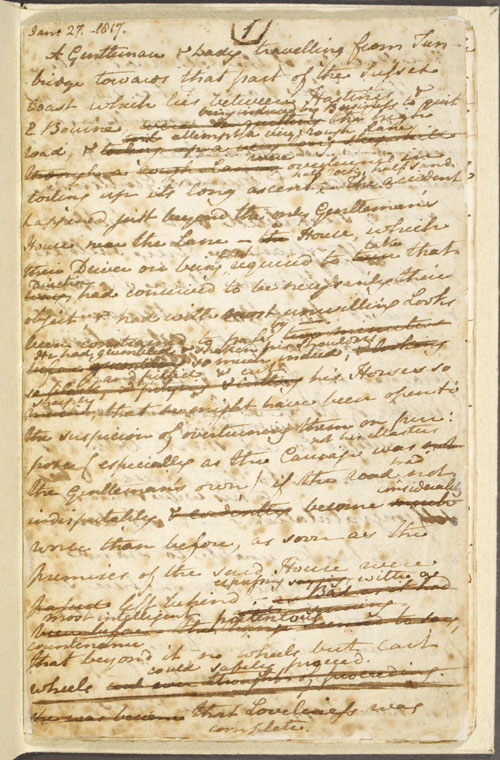
Another rich example is Jane Austen whose punctuation was heavily changed by her editor William Gifford who introduced all those semi-colons which we know and love her for, believing her to be such a subtle graceful stylist. A stylist she certainly was, but perhaps less subtle and more lively. Katheryn Sutherland has led the facsimile digitization of her manuscripts in which we see a much more casual relaxed writer using punctuation in a rhetorical, rather than grammatical, way, feeling herself into the effect of any one sign at any one moment. Sutherland describes her as a ‘conversational’ writer who thrives on writing dialogue, underlining for emphasis, thinking from dash to dash, just as we do when we talk with each other. Austen, she says, punctuates like we would punctuate our emails or text messages today. For use, not correctness.
So, even though an author didn’t care, and the first readership encountered their work through an edited version with changed the punctuation (and the author was alive and involved enough to have had the right at least to object), it’s still important to know about the punctuation changes, and to have access to the original in facsimile form. It tells us about the writing process, and it tells us more about the way an author thought as becomes clear in the case of Austen and Clare.
And then there was Emily Dickinson.
Despite editing trends in the latter part of the twentieth century that seek to un-edit earlier works, for instance focussing on original spelling, lay-out, or type, punctuation has yet to be included in the accidentals that deserve preservation.
Perhaps, only facsimiles will offer an adequate conservation of original punctuation, although handwriting and idiosyncratic shaping and placing of marks may hamper readerly engagement at first.
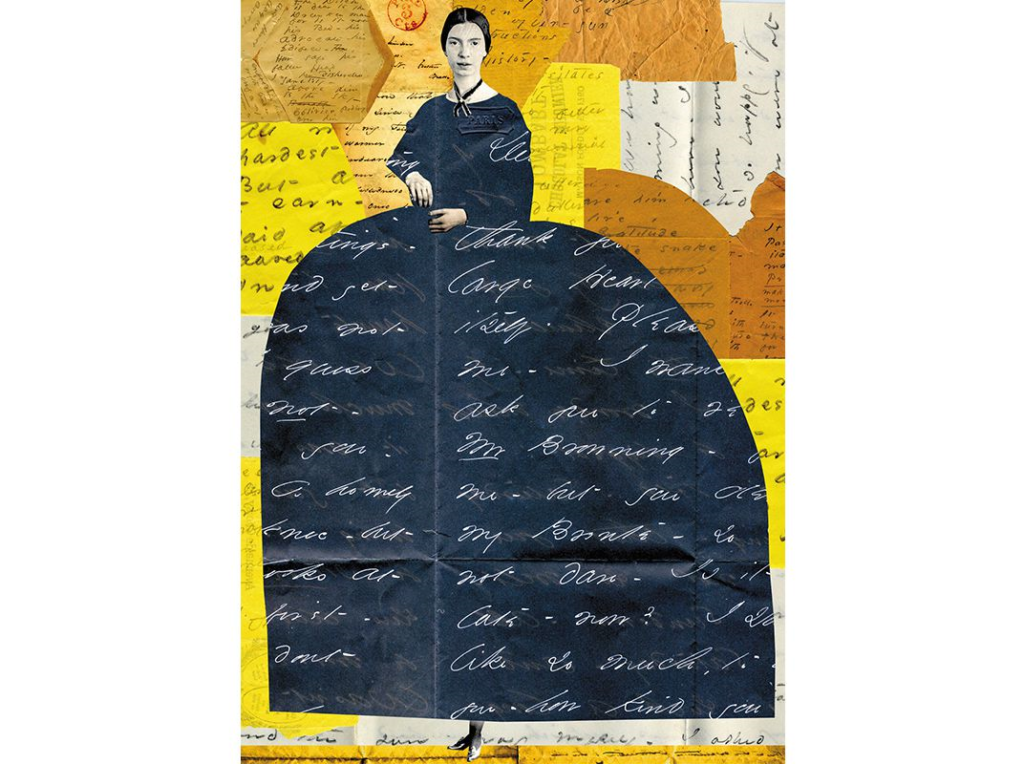
The history of Emily Dickinson’s work makes a case in point for the need to have accessible facsimiles: early posthumous publications of her poems from 1890 onwards show intrusive editorial decisions such as the addition of titles, changes of words to force rhymes, changes in pronouns, and systematic erasure of Dickinson’s now trademark dashes. Only in 1955 did an edition by Thomas Johnson come out that worked from her original manuscripts, but the editor still had to make a choice as to the length and placing of her dashes for his typewritten transcription that merely allowed standardized marks. The 1981 facsimile edition by R.W. Franklin, then, reproduces the original with all its quirks and complexities attendant to handwriting. Editing punctuation, more often than not, means taming what does not fit preconceived notions of the norm and (particularly for women writers) propriety.
And anyway, she didn’t want her work to be published at all, so it seems doubly unfair to publish and then to edit.
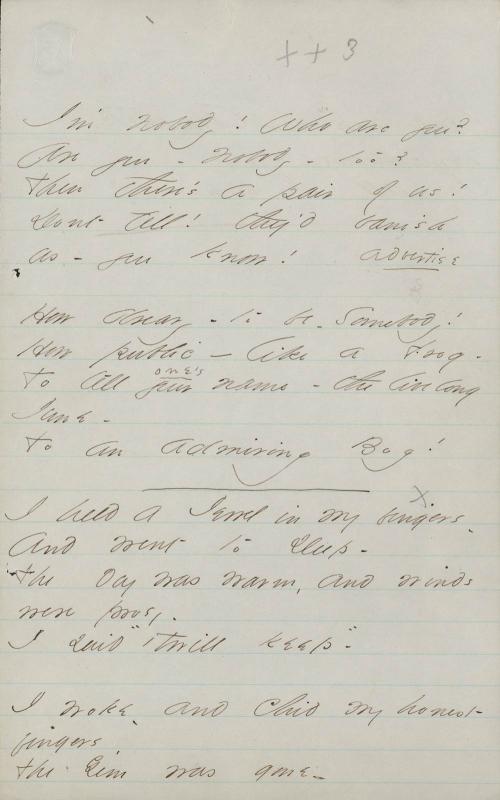
‘I’m Nobody! Who are you?’ Note the different lengths of dashes at different levels of the line. How to represent these with standardized punctuation?
The bibliographical history of Dickinson clearly comes down on the side of facsimiles, I think; that of Austen is a little more ambiguous, and one certainly wants access to both, the first editions by which she came to be known, as well as her original writing.
What’s also intriguing in Austen’s work is that this collaboration between writer and editor undercuts assumptions of The One and Only Text, the authorial ur-text uncorrupted by biased uninformed editors and printers, indeed it undercuts the very concept of author itself.
I wouldn’t call myself a disciple of Barthes. I don’t think the author is dead. But I do think a work is more than mere text, that is, words, and I do think the sociology of bibliography via Jerome McGann gets it right: a literary work, its significance, meaning, whole fuzzy being, is made up by and possesses multiple forces including the author(s), editor, publisher, printer, type-setter, designer, translator, book seller, reader, and so on.
Editing traditions have come a long way regarding this. Perhaps too long? The New Oxford Shakespeare edited by Gary Taylor et al. from 2018 went full out in terms of authorship ascription/attribution. We read that Arden of Faversham is by Shakespeare and Anon., Marlowe (and Anon.) had a hand in the Henry VI plays, Heywood, Peele, Fletcher, Wilkins, Middleton — a dizzying array of collaboration, as well there might have been in the early modern dramatists scene. The most radically inclusive of editors, however, still doesn’t think punctuation deserves to be counted as substantial, and so it falls through the cracks of bibliography yet again.
What else do we do? Where do we go from here?
Rather than to ask whether any mark is right or wrong, we should be asking: does the punctuation here matter for the text’s meaning? And does it matter who put it there if it says something interesting?
Punctuation helps think through some of those really big concepts and approaches of literary criticism (and editing, and history, and). It helps us develop a sensitivity for the small, the detail, the lack of full stop, but it also puts our seriousness into perspective: Byron was a sad hand at it, so let’s not hang ourselves over a comma.
Punctuation helps us tolerate ambiguity, negotiate those shades of meaning, and in doing so, it tells us more about ourselves, the readers, than about any authorial intention, adept or otherwise. [last updated 31 August]
